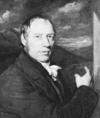- Trevithick, Richard
-
died April 22, 1833, Dartford, KentBritish inventor of the first steam locomotive.With little formal education, in 1790 he became an engineer for several ore mines in Cornwall. In 1797 his experiments with high-pressure steam led him to develop a small, light engine to replace the large, low-pressure mine engines then used for hoisting ore. In 1801 he built the first steam carriage, which he later drove in London. In 1803 he built the first steam railway locomotive for an ironworks in Wales. He abandoned his locomotive projects in 1808 because the iron rails were too fragile to carry their weight. He adapted his engine to produce the first steam dredger in 1806. In 1816 he traveled to South America to deliver engines to Peruvian silver mines, hoping to become wealthy, but returned to England in 1827 penniless.
 Richard Trevithick, detail of an oil painting by John Linnell, 1816; in the Science Museum, London.Courtesy of the Science Museum, London, the Woodcroft Bequest
Richard Trevithick, detail of an oil painting by John Linnell, 1816; in the Science Museum, London.Courtesy of the Science Museum, London, the Woodcroft Bequest* * *
▪ English engineerborn April 13, 1771, Illogan, Cornwall, Eng.died April 22, 1833, Dartford, KentEnglish mechanical engineer and inventor who successfully harnessed high-pressure steam and constructed the world's first steam railway locomotive (1803). In 1805 he adapted his high-pressure engine to driving an iron-rolling mill and to propelling a barge with the aid of paddle wheels.Trevithick spent his youth at Illogan in the tin-mining district of Cornwall and attended the village school. The schoolmaster described him as “disobedient, slow and obstinate.” His father, a mine manager, considered him a loafer, and throughout his career Trevithick remained scarcely literate. Early in life, however, he displayed an extraordinary talent in engineering. Because of his intuitive ability to solve problems that perplexed educated engineers, he obtained his first job as engineer to several Cornish ore mines in 1790 at the age of 19. In 1797 he married Jane Harvey of a prominent engineering family. She bore him six children, one of whom, Francis, became locomotive superintendent of the London & North Western Railway and later wrote a biography of his father.Because Cornwall has no coalfields, high import costs obliged the ore-mine operators to exercise rigid economy in the consumption of fuel for pumping and hoisting. Cornish engineers, therefore, found it imperative to improve the efficiency of the steam engine. The massive engine then in use was the low-pressure type invented by James Watt (Watt, James). Inventive but cautious, Watt thought that “strong steam” was too dangerous to harness; Trevithick thought differently. He soon realized that, by using high-pressure steam and allowing it to expand within the cylinder, a much smaller and lighter engine could be built without any less power than in the low-pressure type.In 1797 Trevithick constructed high-pressure working models of both stationary and locomotive engines that were so successful that he built a full-scale, high-pressure engine for hoisting ore. In all, he built 30 such engines; they were so compact that they could be transported in an ordinary farm wagon to the Cornish mines, where they were known as “puffer whims” because they vented their steam into the atmosphere.Trevithick built his first steam carriage, which he drove up a hill in Camborne, Cornwall, on Christmas Eve 1801. The following March, with his cousin Andrew Vivian, he took out his historic patent for high-pressure engines for stationary and locomotive use. In 1803 he built a second carriage, which he drove through the streets of London, and constructed the world's first steam railway locomotive at Samuel Homfray's Penydaren Ironworks in South Wales. On Feb. 21, 1804, that engine won a wager for Homfray by hauling a load of 10 tons of iron and 70 men along 10 miles of tramway. A second, similar locomotive was built at Gateshead in 1805, and in 1808 Trevithick demonstrated a third, the Catch-me-who-can, on a circular track laid near Euston Road in London. He then abandoned these projects, because the cast-iron rails proved too brittle for the weight of his engines.In 1805 Trevithick adapted his high-pressure engine to driving an iron-rolling mill and propelling a barge with the aid of paddle wheels. His engine also powered the world's first steam dredgers (1806) and drove a threshing machine on a farm (1812). Such engines could not have succeeded without the improvements Trevithick made in the design and construction of boilers. For his small engines, he built a boiler and engine as a single unit, but he also designed a large wrought-iron boiler with a single internal flue, which became known throughout the world as the Cornish type. It was used in conjunction with the equally famous Cornish pumping engine, which Trevithick perfected with the aid of local engineers. The latter was twice as economic as the Watt type, which it rapidly replaced.Trevithick, a quick-tempered and impulsive man, was entirely lacking in business sense. An untrustworthy partner caused the failure of a London business he started in 1808 for the manufacture of a type of iron tank Trevithick had patented; bankruptcy followed in 1811. Three years later, nine of Trevithick's engines were ordered for the Peruvian silver mines, and, dreaming of unlimited mineral wealth in the Andes Mountains, he sailed to South America in 1816. After many adventures, he returned to England in 1827, penniless, to find that in his absence other engineers, notably George Stephenson, had profited from his inventions. He died in poverty and was buried in an unmarked grave.L.T.C. RoltAdditional ReadingH.W. Dickinson and Arthur Titley, Richard Trevithick: The Engineer and the Man (1934), the definitive book on its subject, includes many drawings and sketches by Trevithick, a complete list of his patents, and a bibliography. L.T.C. Rolt, The Cornish Giant: The Story of Richard Trevithick, Father of the Steam Locomotive (1960), is a short biography for the nontechnical reader.* * *
Universalium. 2010.
